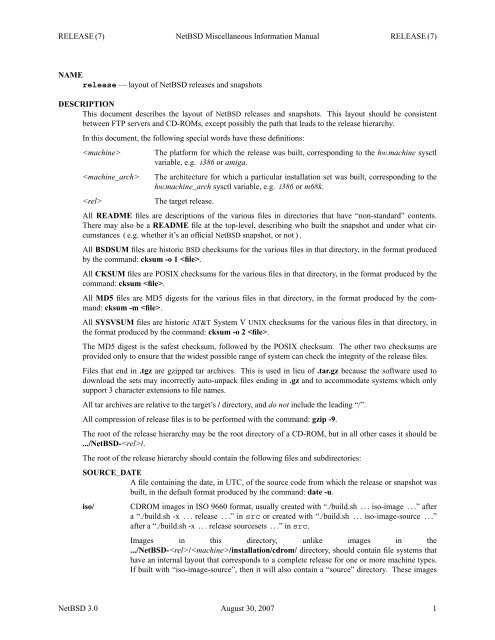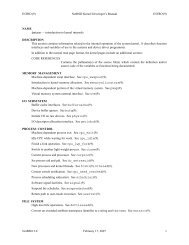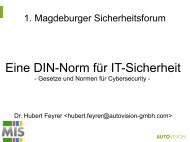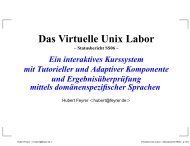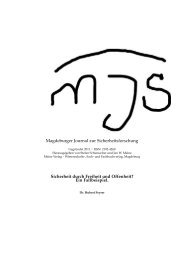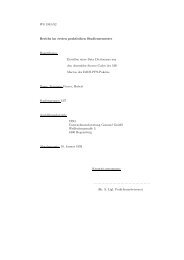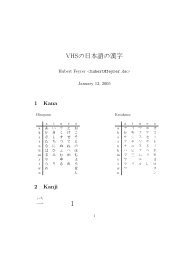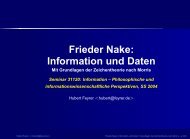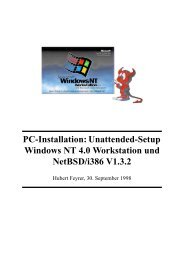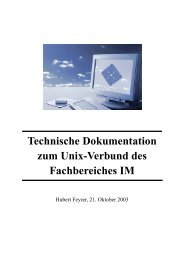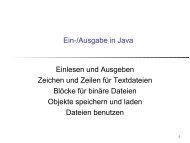INTRO (7) NetBSD Miscellaneous Information Manual INTRO (7 ...
INTRO (7) NetBSD Miscellaneous Information Manual INTRO (7 ...
INTRO (7) NetBSD Miscellaneous Information Manual INTRO (7 ...
You also want an ePaper? Increase the reach of your titles
YUMPU automatically turns print PDFs into web optimized ePapers that Google loves.
RELEASE (7) <strong>NetBSD</strong> <strong>Miscellaneous</strong> <strong>Information</strong> <strong>Manual</strong> RELEASE (7)<br />
NAME<br />
release —layout of <strong>NetBSD</strong> releases and snapshots<br />
DESCRIPTION<br />
This document describes the layout of <strong>NetBSD</strong> releases and snapshots. This layout should be consistent<br />
between FTP servers and CD-ROMs, except possibly the path that leads to the release hierarchy.<br />
In this document, the following special words have these definitions:<br />
<br />
<br />
<br />
The platform for which the release was built, corresponding to the hw.machine sysctl<br />
variable, e.g. i386 or amiga.<br />
The architecture for which a particular installation set was built, corresponding to the<br />
hw.machine_arch sysctl variable, e.g. i386 or m68k.<br />
The target release.<br />
All README files are descriptions of the various files in directories that have “non-standard” contents.<br />
There may also be a README file at the top-level, describing who built the snapshot and under what circumstances<br />
( e.g. whether it’s anofficial <strong>NetBSD</strong> snapshot, or not ).<br />
All BSDSUM files are historic BSD checksums for the various files in that directory, inthe format produced<br />
by the command: cksum -o 1 .<br />
All CKSUM files are POSIX checksums for the various files in that directory, inthe format produced by the<br />
command: cksum .<br />
All MD5 files are MD5 digests for the various files in that directory, inthe format produced by the command:<br />
cksum -m .<br />
All SYSVSUM files are historic AT&T System V UNIX checksums for the various files in that directory, in<br />
the format produced by the command: cksum -o 2 .<br />
The MD5 digest is the safest checksum, followed by the POSIX checksum. The other two checksums are<br />
provided only to ensure that the widest possible range of system can check the integrity of the release files.<br />
Files that end in .tgz are gzipped tar archives. This is used in lieu of .tar.gz because the software used to<br />
download the sets may incorrectly auto-unpack files ending in .gz and to accommodate systems which only<br />
support 3 character extensions to file names.<br />
All tar archives are relative to the target’s / directory, and do not include the leading “/”.<br />
All compression of release files is to be performed with the command: gzip -9.<br />
The root of the release hierarchy may be the root directory of a CD-ROM, but in all other cases it should be<br />
.../<strong>NetBSD</strong>-/.<br />
The root of the release hierarchy should contain the following files and subdirectories:<br />
SOURCE_DATE<br />
Afile containing the date, in UTC, of the source code from which the release or snapshot was<br />
built, in the default format produced by the command: date -u.<br />
iso/<br />
CDROM images in ISO 9660 format, usually created with “./build.sh . .. iso-image . ..”after<br />
a“./build.sh -x ... release . ..”in src or created with “./build.sh . .. iso-image-source . ..”<br />
after a “./build.sh -x ... release sourcesets ...”in src.<br />
Images in this directory, unlike images in the<br />
.../<strong>NetBSD</strong>-//installation/cdrom/ directory, should contain file systems that<br />
have an internal layout that corresponds to a complete release for one or more machine types.<br />
If built with “iso-image-source”, then it will also contain a “source” directory. These images<br />
<strong>NetBSD</strong> 3.0 August 30, 2007 1


